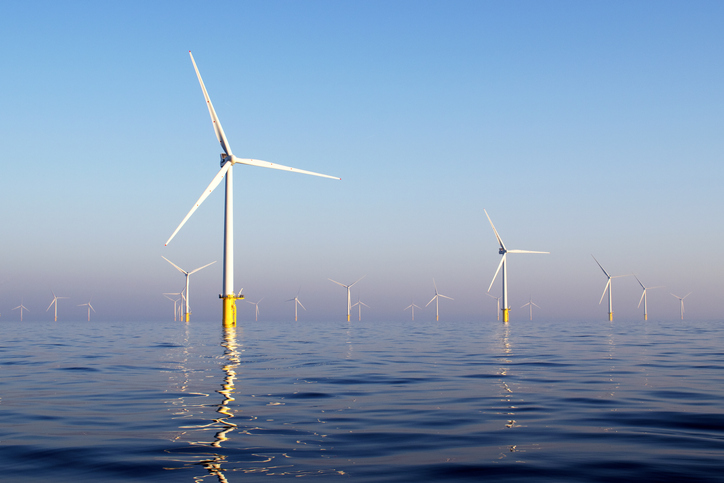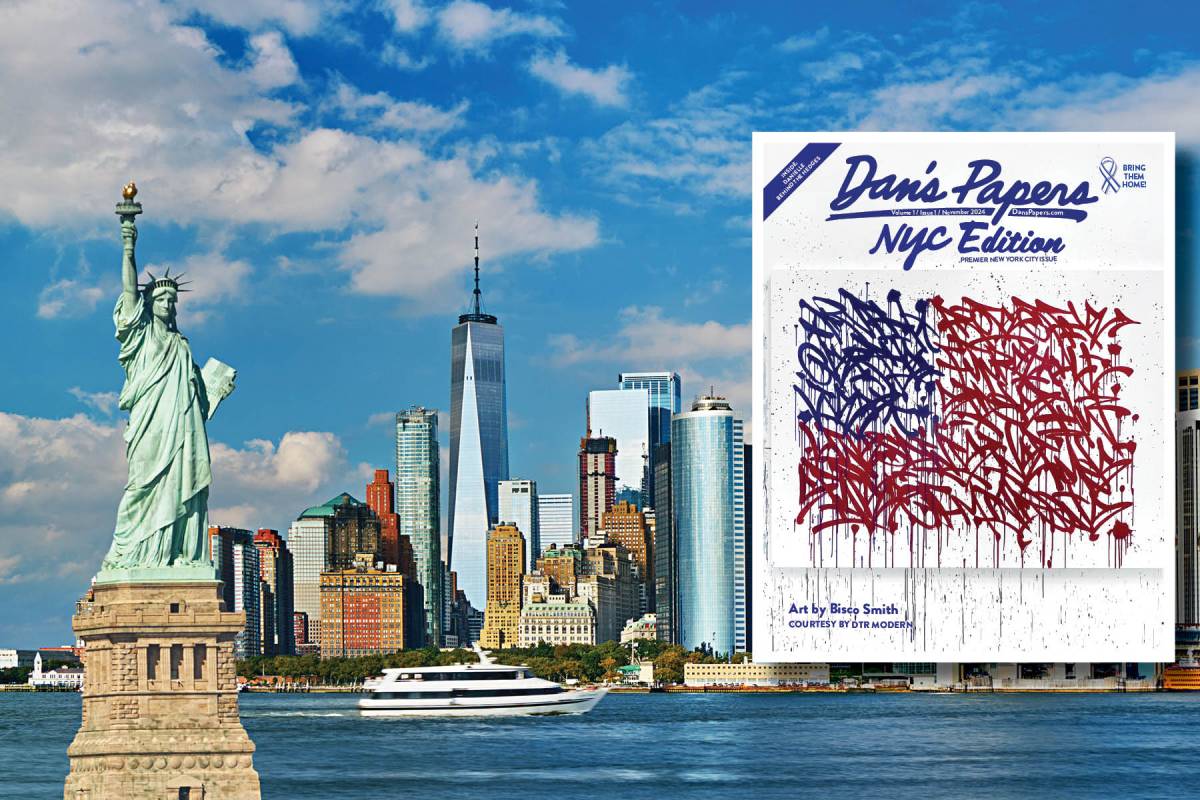The winds of change blew through East Hampton on Feb. 11, as construction, at least symbolically, started on the South Fork Wind project. In a TV studio, local, state and national officials lifted a shovel of dirt while cameras rolled. Why a TV studio? Much of the real work will be done at the bottom of the ocean 35 miles off Montauk Point.
Although solar energy has grown incrementally one panel at a time, wind power is arriving almost suddenly on a massive scale off Long Island at a time when talk of energy independence has accelerated.
Construction of the 12-turbine South Fork project with a capacity of 132 megawatts, enough to power more than 70,000 homes and businesses, appears to be only the beginning.
“America’s clean energy transition is not a dream for a distant future,” Secretary of the Interior Deb Haaland said in a written statement. “It is happening right here and now.”
Long Island is finding that waters beyond its beaches are rich in a little-used resource: wind. The ceremony in East Hampton was only a small part of the region’s welcoming of wind power.
“It would be the first utility-scale project serving New York and one of the very first on the East Coast,” said Fred Zalcman, director of the New York Offshore Wind Alliance, a coalition which aims to promote the responsible development of offshore wind for New York. He noted that Vineyard Wind is also slated to come online in 2023. “It demonstrates that offshore wind can be built in the U.S. and bring environmental and economic benefits.”
Six companies recently agreed to pay $4.37 billion in the New York Bight Offshore Wind Auction, focusing on a shallow triangle off Long Island. The days when wind advocates may have seemed like Don Quixotes are done. The Bureau of Ocean Energy Management is leasing underwater land, so wind farms can be built on the Outer Continental Shelf.
“We had a historic offshore wind energy lease area,” said Mariah Dignan, Long Island regional director for Climate Jobs New York, a statewide labor coalition. “The U.S. offshore industry is nascent. We’re learning from the European experiment.”
The lease for more than 488,000 acres in the New York Bight is the largest such auction to date for the United States. The New York State Energy Research and Development Authority is signing deals to buy wind energy.
The federal leases are for 25 years, but they can be extended, Zalcman said, and there is nothing preventing operation beyond 25 years.
“Equipment is rated for 25 years,” Zalcman added, “but that’s conservative and can be extended through an ongoing maintenance program.”
“It provides long-term revenue certainty,” Zalcman said of contracts to sell power to NYSERDA. “Wind is an intermittent resource. The output does fluctuate with the weather and the seasons, but it’s fairly predictable.”
Environmentalists are advocating for, not against, these big projects as giants grow beyond gas and oil. Ørsted, a Danish company, is partnering with Eversource, New England’s largest energy company, to build South Fork Wind. Germany-based RWE Renewables and National Grid teamed as did EnBW North America and TotalEnergies, a French company. Shell New Energies US is partnering with EDF Renewables North America.
“It is fantastic to see these companies getting into renewables in a big way,” Zalcman said of businesses like BP. “Of the renewables, this is the biggest growth industry for the future.”
New York State and Long Island, in particular, are becoming the hub of wind energy. The breeze you feel when you walk on the beach could soon be lighting your home and powering your computer.
“We’re uniquely positioned to have this resource offshore,” Dignan said. “Globally, we’re the hotspot for offshore wind energy.”
The first offshore wind farms went up in the early 1990s in Europe, with land-based wind turbines repurposed for offshore. “Projects are getting bigger and more efficient. Costs have come down dramatically,” Zalcman said. “Offshore wind is cost competitive with conventional generation and other renewables.”
New York is hoping to ride the wind, possibly because it faces high energy costs. Long Island has a large population and a source of plentiful wind may make this the perfect location for wind power.
“The demand is historic for the American offshore wind industry. We’re anchoring the offshore wind market in New York,” Dignan said. “We have the nation-leading goal in New York of 9,000 megawatts by 2035.”
A 2020 Wood Mackenzie report said wind power should generate “tens of thousands of jobs and billions of dollars in capital investment,” including 80,000 jobs per year from 2025 to 2035. Turbine manufacturing and supply will generate 31,000 jobs per year, including 16,000 for manufacturing, according to the report.
“It’s not only construction and installation,” Dignan added. “It’s operation and maintenance. It’s the manufacturing and the need for a domestic and secure supply chain.”
Ørsted and Eversource partnered with Dominion Energy for the construction of the first U.S.-flagged specialized installation vessel, being built in Texas. “It’s a half a-billion-dollar project,” Zalcman said. “We’re seeing that throughout the supply chain.”
He said it makes sense to build massive equipment near projects rather than overseas. And state programs are incentivizing developers to manufacture in the United States
“As these projects move from conception to steel in the water, we’re seeing investment in ports and harbors and manufacturing taking place domestically,” Zalcman said. “That’s being driven by economics.”
Local ports also will get investment. Port Jefferson is slated to be the home of Ørsted’s Northeast operations and maintenance facility, including the Sunrise Wind project.
“There will be a special operation vessel, like a floating hotel for the operation and maintenance crew,” Zalcman said. “That’ll be home-ported in Port Jefferson.”
The South Brooklyn marine terminal is slated to be used by the developers of the Empire Wind and Beacon Wind projects by Norwegian company Equinor.
Wind farms also are fueling manufacturing. In January, New York Gov. Kathy Hochul keynoted an event at the port of Albany, future home of Marmen Welcon’s manufacturing facility for turbine towers.
While wind has a lot of benefits, it brings some challenges and drawbacks as well. Zalcman said that transmission could become an issue for Long Island offshore, unless upgrades are made to the onshore grid. And then there are what he called “stakeholder issues” such as NIMBY concerns about “ensuring productive coexistence between offshore wind and commercial fishing,” although those can be solved, he said.
Hydropower already supplies much of New York’s power. Wind sweeping over water could come next.
“We’ve got to get this energy around the state too,” Dignan said, noting that power generated by wind could be transmitted statewide. “There’s a ton of work upgrading the grid.”
For more business coverage visit longislandpress.com/category/business
Sign up for Long Island Press’ email newsletters here. Sign up for home delivery of Long Island Press here. Sign up for discounts by becoming a Long Island Press community partner here.
































